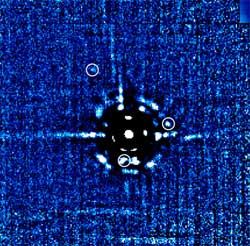First Direct “Chemical Fingerprint” of an Exoplanet orbiting a Sun-Like Star

Image of the HR 8799 system. In the center, the host star HR 8799. Further investigation shows that three of the specks surrounding the star are planets (marked): Starting at 11 o\'clock, clockwise: HR 8799b, HR8799c and HR8799d. The other specks and patterns are artefacts, which are unavoidable in a challenging observation like this one – star and planets are extremely close, and the star is a few thousand times brighter than the planets. The distance from the star to HR 8799c corresponds to 38 times the average Earth-Sun distance. Image credit: MPIA / W. Brandner<br>
Such “chemical fingerprinting” is a key technique in the search for habitable planets around other stars. As such, the result represents a milestone in the search for life elsewhere in the Universe. More directly, results like this are expected to provide new insight into how planets form.
The search for life on other planets is one of the most exciting endeavours of modern astronomy. Over the past decade, astronomers have discovered more than 400 exoplanets (that is, planets orbiting stars other than the Sun). In order to judge a planet's habitability, or even detect tell-tale traces of habitation, astronomers need to do more than just detect such planets: They need to find out what the planet – more specifically, its atmosphere – is made of. To this end, they need to obtain the planet's spectrum, a “chemical fingerprint” that can be measured by examining the light received from the planet. Now astronomers have, for the first time, measured the spectrum of an exoplanet orbiting a Sun-like star directly – an important step in the ongoing search.
The research team, which includes three researchers from the Max Planck Institute for Astronomy (MPIA) and two from Canadian universities, studied the planetary system around the bright, very young star HR 8799, 130 light-years from Earth, located within the constellation Pegasus. The planetary system resembles a scaled-up version of our own Solar System and includes three giant planets, which had been detected in 2008 in another study. “Our target was the middle planet of the three, which is roughly ten times more massive than Jupiter and has a temperature of about 800 degrees Celsius,” says team member Carolina Bergfors (MPIA), who participated in the observations as part of her PhD work. The researchers recorded the spectrum using the NACO instrument installed at the European Southern Observatory's Very Large Telescope (VLT) in Chile, in particular its combined camera/spectrograph CONICA, which was developed at the MPIA and at the Max Planck Institute for Extraterrestrial Physics.
As the host star is several thousand times brighter than the planet, and the two are very close, obtaining such a spectrum is an immense feat. Markus Janson of the University of Toronto, lead author of the paper reporting the new findings, explains: “It's like trying to see what a candle is made of, by observing it next to a blinding 300 Watt lamp – from a distance of 2 kilometres [1.3 miles].” Carolina Bergfors (MPIA), whose work on this project is part of her PhD studies, adds: “It took more than five hours of exposure time, but we were able to tease out the planet's spectrum from the host star's much brighter light.”
In time, the astronomers hope that this technique will help them gain a better understanding of how planets form. As a likely first step, they aim to record the spectra of the two other giant planets orbiting HR 8799 – which would represent the first time that astronomers would be able to compare the spectra of three exoplanets that form part of one and the same system. As a much more distant goal, the technique will allow astronomers to examine exoplanets for habitability, or even signs of life.
More immediately, the results pose something of a challenge to current models of the exoplanet's atmosphere. “The features observed in the spectrum are not compatible with current theoretical models,” explains MPIA's Wolfgang Brandner, a co-author of the study. “We need to take into account a more detailed description of the atmospheric dust clouds, or accept that the atmosphere has a different chemical composition than previously assumed.”
Contact information
Dr. Wolfgang Brandner (Coauthor)
Max Planck Institute for Astronomy, Heidelberg, Germany
Phone: (0|+49) 6221 – 528 289
E-mail: brandner@mpia.de
Dr. Markus Pössel (PR)
Max Planck Institute for Astronomy, Heidelberg, Germany
Phone: (0|+49) 6221 – 528 261
E-mail: poessel@mpia.de
Background Information
The results described here have been published as M. Janson et al., “Spatially resolved spectroscopy of the exoplanet HR 8799 c”, Letter to Astrophysical Journal.
The team is composed of M. Janson (University of Toronto, Canada), C. Bergfors, M. Goto, W. Brandner (Max-Planck-Institute for Astronomy), and D. Lafrenière (University of Montreal, Canada).
Media Contact
All latest news from the category: Physics and Astronomy
This area deals with the fundamental laws and building blocks of nature and how they interact, the properties and the behavior of matter, and research into space and time and their structures.
innovations-report provides in-depth reports and articles on subjects such as astrophysics, laser technologies, nuclear, quantum, particle and solid-state physics, nanotechnologies, planetary research and findings (Mars, Venus) and developments related to the Hubble Telescope.
Newest articles

“Nanostitches” enable lighter and tougher composite materials
In research that may lead to next-generation airplanes and spacecraft, MIT engineers used carbon nanotubes to prevent cracking in multilayered composites. To save on fuel and reduce aircraft emissions, engineers…

Trash to treasure
Researchers turn metal waste into catalyst for hydrogen. Scientists have found a way to transform metal waste into a highly efficient catalyst to make hydrogen from water, a discovery that…

Real-time detection of infectious disease viruses
… by searching for molecular fingerprinting. A research team consisting of Professor Kyoung-Duck Park and Taeyoung Moon and Huitae Joo, PhD candidates, from the Department of Physics at Pohang University…





















